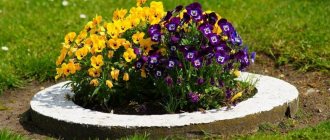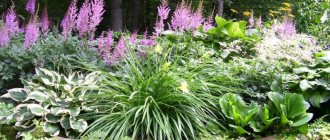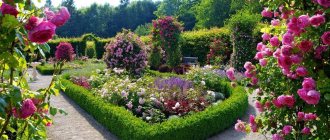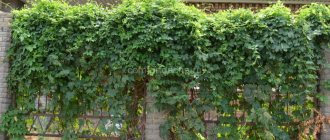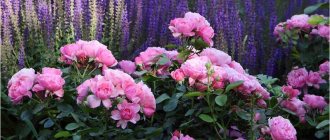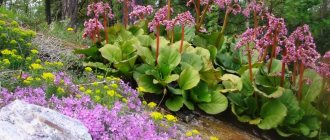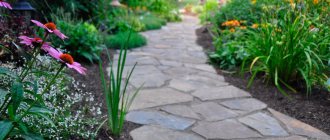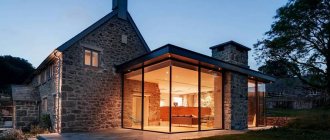Many people want to decorate their gardens. You can always plant a flower garden in a shady place in the garden layout. It is often said that flowers and other greenery do not like to grow in the shade; they prefer the sun. But this is not always true. Yes, many plants love the sun, but there are no less shade-loving plants. The presented flower bed diagrams will help solve the problem of planting plants in shady areas.
A dark area often prevents any gardener from creating a beautiful flower garden. But I really want to create a temple of beauty and aromas out of it, like the Optina flower garden, about which the Monk Macarius spoke: “Inhale the aroma of the flowers that bloom and delight the eye here, when the withered grass in the surrounding area is already drying up.”
What to plant in the shade?
In order to develop the design of a flower garden in front of the house, it is necessary to determine the amount of light falling on the site. It is worth thinking about what kind of soil is allocated for the flower garden. Some of the plants love shade. These are hosta, sedge, hellebore, Rogersia, fern, arizema, bitter weed and others.
Also, fir plants such as thuja, spruce, fir, and juniper love shady conditions. Many different deciduous shrubs. These include elderberry, turf, hawthorn and others.
A shady area of the garden with the right choice of shrubs will delight you with a lush green island and calm colors of flowers.
The choice of a shady area for a flower bed depends on how dry or wet the soil is in the selected area.
The low-growing hosta shrub is the queen of shady flower beds.
The size and shape of the future flower bed are of great importance. The shapes can be varied, ranging from simple geometric to a huge variety of free and sometimes unpredictable shapes.
These rules must be taken into account if the gardener wants to have a plot of continuous flowering from perennials. It is thanks to the right combination that you will be able to observe the splendor of flowering plants throughout the spring and autumn period. Provided the flower garden is diluted with conifers or simply tall herbaceous plants, as well as low-growing border plants from small shrubs such as periwinkle, this piece of the garden, like the Optina flower garden, will delight all year round not only with its appearance, but also with pleasant aromas.
However, when choosing plants for a continuous flowering flower garden, do not forget that their number should be consistent with the size of the area, since instead of pleasant and fragrant beauty you can get chaotic, ill-conceived collections of plants.
As in a fairy tale about an enchanted city, many types of hosta, primrose, and bodan look mesmerizing on the alpine hills.
Many of the astilbe varieties will decorate a shady flower garden in the garden and near a pond.
Low-growing spring-blooming perennials look best in groups in the foreground. These include flowers such as snowdrop, primrose, and hyacinth.
Plants of medium height - tulips, foxgloves - are placed in the middle of the flowerbed, and plants such as the tulip look good individually, and not in a group. In the background, tall plants such as sedum, chrysanthemum and others will naturally grow. Ground cover grasses are planted between them. (Fig.2)
Low-growing perennials
Plants of this group do not exceed 30-50 cm in height. Among them, it is easiest to choose shade-loving flowers for the flowerbed that bloom beautifully in spring and summer.
Spring bulbs (galanthus, crocus, muscari, scilla), liverwort , primrose , corydalis , lily of the valley will decorate shady places immediately after the snow melts, and the trunk circles of still bare trees will bloom.
Noble liverwort
The well-known “blue snowdrop” or “copse” grows in forests, bushes along the edges of forest edges, along the banks of ravines and streams. Belongs to winter-green plants: the characteristic three-lobed leaves remain under snow cover until spring.
Many people grow it as a garden crop. So, more than ten years ago, I brought the liverwort from the forest, dug it up with a clod of earth, and planted it in the front garden of my parents’ house under a cherry tree. The place is illuminated only until lunch, the rest of the time it is in shadow. The seedlings have successfully adapted and still bloom every year.
The liverwort belongs to the Ranunculaceae family, and owes its name to the similarity of the shape of the leaves to the liver
Fragrant violets , violas , and daisies that bloom at the beginning of summer grow well in the light, but planting in the shade benefits them: they will bloom longer and retain their decorative properties.
The community of low shady perennials also includes gravilat , heuchera , and decorative deciduous low-growing varieties of hosta .
Heuchera
Popularity (slightly inferior to hosta), ease of care, durability, decorativeness and a rich color palette of leaf shades - all this is about heuchera, a representative of the Saxifraga family. It is valued for the beauty of its leaves, which can change color during the growing season. Propagated by dividing the bush, green cuttings, and seeds. Shade and places with diffused lighting are suitable for planting.
Heuchera blood-red and many hybrids bred on its basis are long-flowering - flowering continues until late autumn.
Heuchera blood-red reaches 25 cm, and peduncles with red, pink, crimson flowers stretch up to half a meter
Basic rules for arranging a flower garden
Decorating a flower garden requires advance planning. Flowers have the ability to delight with their beauty one by one; in addition, the height or width of some plants may make it difficult for others to show themselves in all their glory.
To do this, you need to analyze the following parameters:
- flowering time;
- degree of growth;
- degree of endurance to low temperatures;
- drought resistance;
- type of soil for the flower garden: alkaline or acidic;
- size.
Are there any benefits to a shaded area?
Definitely yes, first of all - the opportunity to organize a recreation area not in the sun, as an option - building a gazebo or installing a bench.
The range of plants that are used to improve a shaded area is wide, but to get the desired result you will need to take into account:
- soil quality, because most shade-tolerant shrubs grow in deciduous forests, the soils of which are characterized by fertility, looseness, and moisture;
- soils that are too poor will need to be enriched with nutrients; when choosing them, the acidity of the soil should be taken into account;
- level of soil moisture; for shade-tolerant deciduous shrubs it is important that the soil remains moist in hot weather; the need to develop a drainage system for soils that are too wet and heavy. Pebbles or pieces of brick placed at the bottom of the planting holes can be used as drainage.
Taking into account the parameters of the shaded area, it can be wet or dry. To select suitable shrubs, you need to determine the type of shade and select varieties accordingly.
If the shaded area is occupied by large fruit or ornamental trees, then the shade will be dry, because large plants have a strong root system and are able to pump water from the soil, and with it nutrients. Damp shade forms on dense soils in the absence of drainage.
Types of flower beds
In order to arrange a flower garden in front of your house with your own hands, you need to know a few rules. The arrangement of flower beds makes you wonder if there is a shadow around and what creates it. There are different types of flower beds:
- Rabatka. It is she who plays a big role in masking structural defects. Lush plants cover all the errors and irregularities.
- A heterogeneous flower bed that stretches along the path. Plants in a border always look good. These are plants such as hawthorn, petunias, marigolds.
- “Blooming geometry” will look good against the background of a lawn under a flower bed. The shape of the flower bed should be a perfectly even figure: square, circle, oval, etc. Usually they are located somewhere on a hill, which makes it possible to better see the flowers.
- Mixborder. Like the Optina flower garden, it is aimed at living in harmony and joy. Flowers do not fight for water and do not occupy someone else’s space; they have enough sunlight.
- The flowerbed is the main accent of the garden. It should be based not only on bright, catchy flowers, but also small, calmer tones. So, blue, green, violet and lilac colors are chosen for the background. And to create elegance and attractiveness, yellow, red, orange and pink. White, pale blue and soft yellow flowers will help decorate empty spaces. Decorating a flower garden forces you to take into account the laws of color, which can make your soul rejoice and your gaze stop at every moment. The Optina flower garden was developed according to these same principles, as evidenced by its popularity. The color combinations there inspire and pacify, and do not create aggression.
Even in a small, shaded area in front of the house, you can recreate a green taiga island by planting unpretentious fern shrubs, hostas, and astilbes.
The low-growing hosta bush, similar to an ancient giant tortoise, will delight gardeners with 100 shades of green: from soft green to Moroccan emerald.
A soft green bather with purple bells easily takes root in a shady, damp area of the garden.
general characteristics
Contrary to the prevailing stereotype, the range of shade-tolerant plants for the garden is not so small: photos and names indicate a wealth of choice for a keen gardener. Many varieties are unpretentious and will delight even novice and busy gardeners.
It is customary to distinguish two groups of plants:
- shade-loving - not suitable for sunny areas;
- shade-tolerant - tolerate both shading and full lighting.
Each culture is individual in its preference for shade or partial shade, shade for several hours a day or constantly. When choosing, you should also take into account the traditional division of plants into annuals and perennials. Annuals provide a quick decorative effect, while perennials work well for the future.
In general, most of the species presented below can grow in shade and partial shade.
Arrangement of flower beds in semi-shaded places
The tallest is the highlander. Its lush bush grows up to 2 m in height. And the large panicle-shaped inflorescences resemble clouds with their white color. It blooms for approximately 1.5 months, starting in June. However, even after it fades, the inflorescences still continue to attract the eye. The same tall perennial veronicastrum has lilac inflorescences. In front is astilbe, which blooms in July, has large inflorescences and can make a flower garden beautiful even with daylily. Designing a flower garden requires that the bush called loosestrife have pink flowers. These plants thrive in both partial shade and full sun. But blue hostas cannot tolerate sunlight. With its abundance, their beautiful large leaves lose their varietal color and become monochromatic and green.
Flowers for a shaded, damp area of the garden.
Plants for rock gardens and shady areas.
Shade-tolerant ground covers
Groundcover (carpet) is a group of low-growing (up to 30 cm) plants, the main feature of which is the ability to quickly grow and occupy large areas of garden space.
In the shady corners of the dacha, between taller crops, under trees you can safely plant periwinkle , budra , heuchera , creeping tenacious, European hoofweed , lungwort, nettle-leaved mikhina , pachysandra, spleenwort , gooseberry , tiarella , and clearweed . All of them form a kind of carpet, decorative for a long time, and evergreen species (periwinkle, pachysandra) persist even in winter.
Creeping tenacious (ayuga, aishuga)
A low, pubescent plant from the Lamiaceae family. The leaves are oval, the lower ones form a basal rosette, from which quickly rooting shoots – tendrils – grow. Blooms from April to July. The peduncle has a tetrahedral stem up to 35 cm high. The two-lipped blue flowers are collected in spike-shaped inflorescences, which remain beautiful for a long time even after flowering. Propagated by seeds, division, cuttings.
Today, many varieties of creeping tenacious have been bred, differing in the shape and color of the leaves.
Lungwort
A representative of the Borachnikov family has a rough stem, lanceolate pubescent leaves and flowers of pink, blue, and white colors, blooming on one plant. This is a good honey plant, hence the Russian name of the flower.
The most popular among flower growers are variegated (variegated) varieties of lungwort: white and silver spots can be located pointwise, in the center, or in the form of a border along the edges of the leaf.
Pachysandra
A little-known evergreen ground cover from the Boxwood family. Valued for its beautiful, unusual shape of glossy leaves, fast growth, unpretentiousness, and frost resistance. Grows under trees, along garden paths, and even tolerates full shade.
Pachysandra apex is most often grown in culture.
Flower garden for shady places
Often a place is chosen for a flower garden near the fence, where there is usually an empty space. You can plant chebushnik right next to it. It is quite tall, has pink flowers, which will look good against the background of a plain fence. Chebushniks come in several types and have inflorescences of different colors, but their main attraction is the aroma of the flowers, which is different for each variety. Foxglove - this plant will delight the gardener for 2 years with its large pinkish flowers.
Lupins are perennial plants. They bloom in June. Pale yellow flowers are collected in brushes. However, when they fade, they have an unsightly appearance. Therefore, such flowers should be planted in small groups. In front you can plant a cuff and incense. The fluffy round leaves of the cuff look great next to the leaves of the bergenia. They are large, dark green, and have a shiny appearance. The cuff, starting in June, blooms all summer until August. Its small pale yellow flowers are collected in an airy inflorescence. Daylilies look very beautiful against the background of this entire composition. It is best to remove their small yellowish flowers as soon as they fade.
Plants for rock gardens and shady areas.
Near Moscow region, centuries-old spruce trees, a country village, an alpine hill in a shady place, carefully tended by a gardener. Find familiar plants.
Herbs that tolerate shade well
In shaded areas, some herbaceous crops do quite well. Shade-loving herbs will be described in more detail below.
Ozhika forest and snow
Ozhika snowy
Ozhika forest and snowy is a perennial shade-tolerant plant that is quite popular among gardeners. It is often planted under bushes or trees. However, the hedgehog may die if it remains in deep shadow all the time.
Ozhika forest
Forest grass is an evergreen plant whose foliage is covered with long hairs.
Fescue
Swamp fescue, or gray fescue, or low sedge is a semi-evergreen or evergreen perennial plant belonging to the Poaceae family. It grows well in shaded areas.
Rules for creating continuous flowering
Plants can grow very large over time, and the beauty of the flower garden in front of the house will be hidden in greenery, so it is important to plant perennials at a large distance from each other. Initially, you can fill in between them with annuals.
Until the perennials grow to the required size, it will be clear whether the gardener has chosen the right place for these plants.
Flowers that have faded and lost their attractiveness are best surrounded by lower plants. For example, hostas or daylilies can be planted near daffodils.
Flower garden design in front of the house
Every gardener, when planting flowers, has the goal of enjoying the beauty of the greenery around him and being in harmony with nature.
You can plant a magnificent flower garden in front of your house with your own hands, but before starting work you need to make sure that the diagram corresponds to the real area, mark the boundaries, and fertilize the soil.
It is advisable to plant plants sparingly, as they will grow.
Upon completion of the work, it is necessary to set up the border, because... there is a danger of trampling future beauty.
If you are not lazy in caring for the flowers near your house, watering and fertilizing the soil in a timely manner, removing weeds and faded buds, then arranging flower beds in the garden will create a small corner of happiness that will delight all its inhabitants with its appearance.
Recommendations for agricultural technology
Considering the unpretentiousness and endurance of plants, you should follow simple rules when caring for them:
- Site preparation . Before planting, you need to pay attention to the condition of the ground. It should be quite fertile and light. If necessary, add loose leaf soil and peat. Most perennials grow naturally in acidic soils. The addition of peat acidifies them. The site is dug up and weeds are selected. It is advisable to lay a layer of drainage (stones, broken bricks) in planting holes under tall plants.
- Humidity . Shade species are mostly moisture-loving and require regular and timely watering, especially in spring. To maintain moisture in the soil, mulching is carried out.
- Application of fertilizers . Complex mineral fertilizers or organic infusions promote normal growth, development, flowering of perennials, and reduce competition for nutrients.
- Loosening and removing weeds . It is better not to disturb ground covers, especially since the dense cover they form does not allow weeds to break through.
- divide clumps and bushes in spring or autumn. In cool times, the survival rate of daughter plants is higher.
Lovers of bright combinations plant multi-colored daisies, forget-me-nots, and violas in flower beds.
Daisies, violas, and forget-me-nots are easy to grow by sowing seeds in open ground. In July, seeds are sown on a seedling bed (or other designated location). The seedlings will remain there until July, and already in August, when the seedlings have grown well, they are transplanted to a permanent place. Next year they will delight you with their flowering.
Companion plants
Shrubs alone are not enough to decorate the shaded corners of the garden. It is necessary to select other plants so as to form a decorative landscape that pleases the eye throughout the season. For this, shade-loving perennials, ferns, and conifers are used.
Companion plants include the following species:
- Climbing plants. Most vines come from the undergrowth, so they are ideally suited for life in the shade. Lianas are useful for decorating a gazebo or pergola, and they will not suffer at all from a lack of sun. It looks spectacular and blooms beautifully in the shade, and forms dense thickets of kirkazon and maiden grapes. The foliage of the latter acquires a bright red-orange color by autumn.
- Ferns. Ferns of various sizes, thanks to the clear graphics and volume of the leaves, create an ideal background for flowering plants.
- Hosts. The most amazingly diverse plant that prefers to grow in the shade. Selection has given gardeners many varieties of different sizes (from 10 to 60 cm). The leaves are varied in shape and color. There are green, yellowish, blue, gray, with light (or, conversely, dark) edging options. In the design, hostas are successfully combined with ferns.
- Ground cover plants. Fill the space with a dense carpet, including under trees; many species bloom beautifully. Shade-tolerant plants include saxifrage, lungwort, and periwinkle.
- Flowers and cereals. Shaded places are well tolerated by geranium, fragrant tobacco, daisy, matthiola bicorne, forget-me-not, and rudbeckia. You don’t have to be afraid to plant daffodils, tulips and crocuses - they will bloom before thick foliage appears on the trees. Grasses love the sun, but in partial shade the turf pike, the common hedgehog, the meadow foxtail and the spreading pine tree will take root.
Hazel
This plant prefers to grow only in non-acidic soil. If the soil is acidic, then it is recommended to add sand to it. Quite tasty nuts grow on hazel.
Gooseberry
It can grow in both sunny and shaded places. And such a shrub needs to be watered quite rarely and moderately, and it can withstand a dry period. The plant produces very tasty berries, which are often used to make jam.

